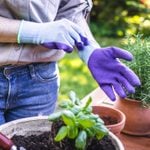What Is a No-Till Garden?

Less work, less money and healthier ecosystems. Here's why no-till gardening might be your next move.
We might be fussing over our gardens so much that we’re actually harming them. As it turns out, all of that tilling, spading, hoeing and weeding can be destructive because it disrupts the habitats and hard work of all those helpful little creatures who turn our plain dirt into rich soil.
No-till gardens, AKA no-dig gardens, are growing in popularity because of their effectiveness and environmental benefits.
In a no-till garden, you don’t turn or mix the soil to prep it for planting. Instead, you just add amendments to the top, then cut spent plants at the soil line instead of yanking them out. This keeps the soil’s structure intact, protects its diversity of life, and provides ample space for water and oxygen to reach roots.
While many experts, including our Family Handyman editors, promoted tilling in the past, new technologies are helping soil scientists better understand what’s happening underground.
“Tilling has been a widely accepted practice for centuries, but we had very little understanding of soil and its many complexities,” says Kathy Glassey, director of renewable resources for Monster Tree Service.
“We used to believe we would break up soil to ensure our seeds had adequate, uncompacted areas in which to flourish. But what we know now is just how devastating this practice is to soil structure and biodiversity. As we continue to evolve and learn in the industry, we now understand what occurs beneath us, and it’s incredible.”
Here are some of the benefits of a no-till garden.
On This Page
Better Soil Structure
Soil is more than dirt. It’s a complex structure of interwoven pathways, residues, nutrients and life. When soil is allowed to retain its structure, it stays more resilient and healthy. Your plants will do the same.
Increased Water Retention
When soil has good structure, it absorbs water better and slows evaporation. That means you can water less and lower your water bill.
Less Erosion and Healthier Watersheds
Well-structured soil is less likely to erode, keeping your topsoil in place and preventing runoff from polluting water downstream. “As it turns out, keeping the residue on the soil surface, rather than tilling it under, not only protects the soil from erosion, it also helps migratory waterfowl,” says Mary Phillips, head of Garden for Wildlife.
Increased Carbon Sequestration
Plants absorb carbon from the air and transfer it into the soil. Microorganisms in soil also store carbon. “Tilling disrupts the natural cycle of carbon storage and releases it into the atmosphere, increasing climate temperatures,” says Phillips.
Greater Weed Control
The organic weed maintenance practices in no-till gardening, like landscape cloth, mulching and hand weeding, are often more effective and thorough than other methods.
“One of the misnomers of tilling is that it is thought to kill weeds,” says Phillips. “Unfortunately, it only kills weeds at the surface. The turning redistributes weed seeds into the ground that then come to the surface when they germinate.”
More Nutrients, Less Fertilizer
When not disrupted, underground communities of microorganisms and earthworms thrive. That’s important because they break down organic matter and supply micronutrients and minerals to the plants. The healthier their ecosystem, the more nutrient-dense the plants will be, and the less fertilizer you’ll be tempted to add.
Less Physical Effort
Yeah, you heard that right. This is one of the few instances in life where not doing something actually works to your benefit.
Fewer Diseases and Pests
Greater biodiversity in the soil means there will also be a greater diversity of insects above it. Both help maintain a natural balance, which keeps pests and diseases in check. So there’s less of a chance you’ll need pesticides or other interventions.
Less Fossil Fuel
No-till means you can retire the power tilling equipment. That reduces greenhouse gasses and other pollution in the air we breathe.
Money Saved
No power equipment and gas, less water and less fertilizer all adds up to more money to buy more seeds!



